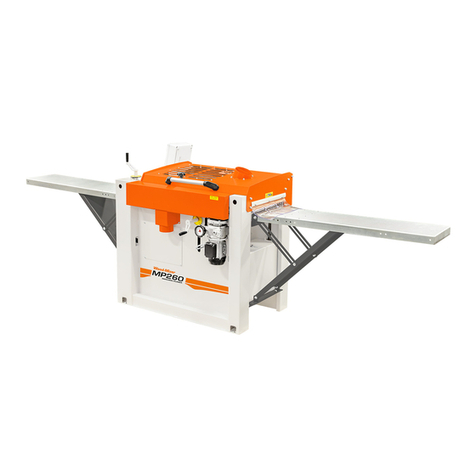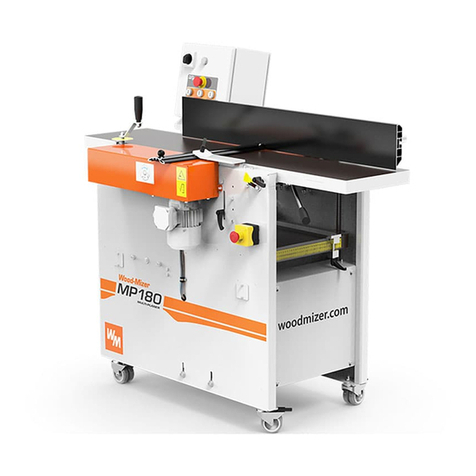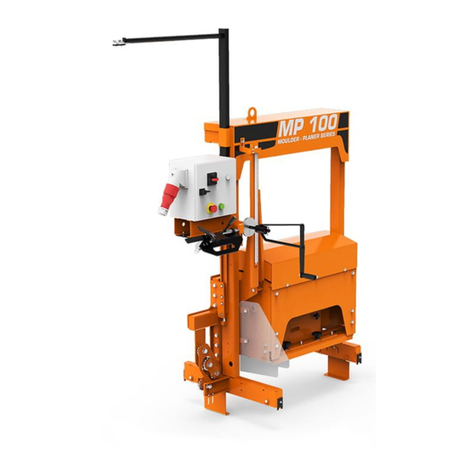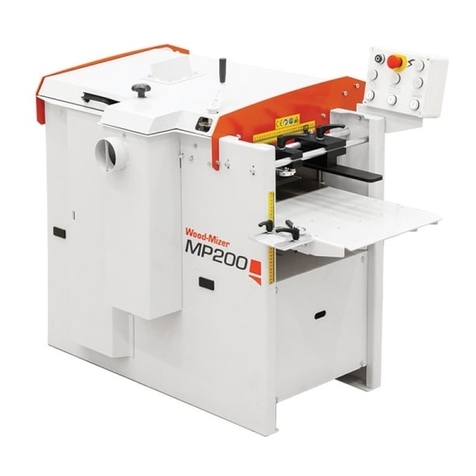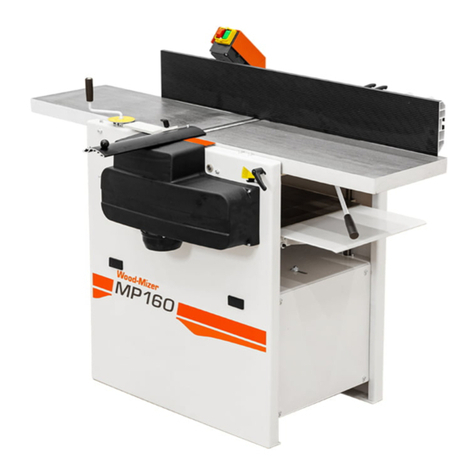
Wood-Mizer MP360
Warrantor’s Obligations as To Defects
In the event that the equipment failsto perform due to defective materials orworkmanship attributable to Warrantor
under normal use and service within the established warranty period, Purchaser’s sole and exclusive remedy and
Warrantor’s sole liability shall be to replace or repair, in Warrantor’s sole and subjective discretion, any defective part
at Warrantor’s principal place of business without cost to the Purchaser if such defect exists. The determination of
whether a product is defective shall be made by Warrantor in Warrantor’s sole and subjective discretion. The
Purchaser must notify Warrantor prior to shipping any defective part. Warrantor, at its sole discretion, may cover
expenses incurred in shipping the defective part to Warrantor for evaluation; provided, however, that Warrantor will not
be responsible for labor, travel time, mileage, removal, installation or incidental or consequential damages. However,
any part in excess of 140 pounds must be returned by the Purchaser, to the Warrantor’s nearest authorized facility at
the Purchaser’s expense, if return is requested by Warrantor. Warrantor shall have a reasonable time within which to
replace or repair the defective part. IfWarrantor determines that the product is not defective under the terms of this
warranty in Warrantor’s sole and subjective discretion, then Purchaser shall be responsible for any expenses incurred
by Warrantor in returning the equipment to the Purchaser.
Limitations and Disclaimers of Other Warranties
EXCEPT FOR THE EXPRESSWARRANTY PROVISIONS STATED ABOVE,WARRANTOR DISCLAIMS ALL
WARRANTIES, EXPRESS AND/OR IMPLIED, INCLUDINGWITHOUT LIMITATION, THE IMPLIED WARRANTIES
OF MERCHANTABILITY, AND FITNESS FOR A PARTICULAR PURPOSE, NONINFRINGEMENT AND TITLE. No
representation or other affirmation of fact by representatives of Warrantor, whether verbal or in writing, including
photographs, brochures, samples, models, or other sales aids, shall constitute a warranty or other basis for any legal
action against Warrantor. There are no other representations, promises, agreements, covenants, warranties,
guarantees, stipulations or conditions, express or implied, by Warrantor except as expressly set forth herein. THE
ORIGINAL PURCHASER AND ANY INTENDED USER OR BENEFICIARY OF THIS EQUIPMENT, SHALL NOT BE
ENTITLED TO RECOVER ANY INDIRECT, SPECIAL, PUNITIVE, EXEMPLARY, CONSEQUENTIAL, SPECIAL,
OR INCIDENTIAL DAMAGES OR LOSES, INCLUDING BUT NOT LIMITED TO, DAMAGES OF LOST
PRODUCTION, LOST REVENUE, LOST PRODUCT, LOST PROFITS, LOST BUSINESS, LOSS OF USE, LOSS
OF GOODWILL, OR BUSINESS INTERRUPTION, FROM WARRANTOR FOR ANY REASON WHATSOEVER
INCLUDING WITHOUT LIMITATION WARRANTY OR DEFECT IN THE PRODUCT REGARDLESS OF THE SOLE,
JOINT AND/OR CONCURRENT NEGLIGENCE, BREACH OF CONTRACT, BREACH OF WARRANTY, STRICT
LIABILITY IN TORT OR STATUTORY CLAIMS OR OTHER LEGAL FAULT OR RESPONSIBILITY OF EITHER
WARRANTOR OR PURCHASER OR ITS EMPLOYEES OR AGENTS. Warrantor does not warrant that its
equipment meets or complies with the requirements of any particular safety code or governmental requirements.
Defective items replaced underthe terms of this warranty become the property of Warrantor.
Design Changes
Warrantor reserves the right to change the design of its products from time to time without notice and without
obligation to make corresponding changes in or to its products previously manufactured.
Rights of Purchasers
The validity and effect of this limited warranty as well as its interpretation, operation and effect, shall be determined
exclusively by the principles of law and equity of the State of Indiana, USA. This limited warranty gives Purchaser
specific legal rights. Purchaser may also have other rights, which may vary from state to state. Some states may not
allow limitations as to the duration of implied warrantiesor to the exclusion or limitationof incidental or consequential
damages, so some of the limitations and exclusions detailed set forth above may not apply. In the event that any one
or moreof the provisions of this warranty shall be or becomeinvalid, illegal or unenforceablein any respect, the
validity, legality and enforceability of the remaining provisions of this warranty shall not be affected thereby.
Interpretations
ThisWarranty constitutes the entire warrantyagreement between Warrantor and Purchaser and supersedesany prior
understandings or agreements pertaining to the same subject matter. This warranty cannot be amended except in
writing which refers to this warranty which is signed byboth Warrantor and Purchaser.
© 2018 Wood-Mizer LLC – 8180 West 10
th
Street, Indianapolis, IN 46214
FORM#1814ENG






